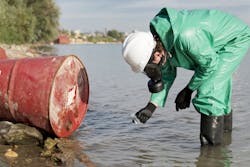Contaminated wastewater that spilled from an abandoned Colorado mine and flowed downstream toward two other states, poses a real liability problem for the U.S. Environmental Protection Agency and its cleanup contractor, according to a partner in the international law firm Dorsey & Whitney.
On Aug. 5, while investigating the Gold King Mine in Colorado, an EPA cleanup team triggered a large release of mine wastewater into Cement Creek. The Colorado mine spill of some 3 million gallons of toxic wastewater is three times larger than originally estimated, federal officials say.
READ ALSO: EPA Study Shows Hydraulic Fracturing Has No Impact On Drinking Water Resources
"EPA frequently hires emergency contractors to address the release of hazardous substances at mining and other industrial and commercial facilities,” says Thaddeus Lightfoot, a partner at Dorsey & Whitney. “These contractors are highly trained, so it is unusual when they make a mistake. But it appears that is what happened at the Gold King Mine near Durango, where an EPA cleanup crew destabilized a dam of loose rock lodged in the mine, releasing contaminated mining sludge. Where EPA contactors have made such mistakes in the past, courts have held them liable for any additional remediation required by such actions despite statutory immunity provisions.
“At the Gold King Mine, it appears that EPA employees, or a contractor that EPA retained, were tasked with removing sludge contaminated with arsenic, lead, copper, aluminum, and cadmium,” says Lightfoot. “All of these metals are hazardous substances under the federal Superfund statute, the Comprehensive Environmental Response, Compensation and Liability Act of 1980 (CERCLA).”
Although Section 119 of CERCLA provides immunity for releases of hazardous substances caused by EPA employees and cleanup contactors, Thaddeus says the immunity does not apply if a party would have otherwise been liable for cleanup costs under CERCLA. Typically, cleanup contractors are not liable for cleanup costs as “operators” of a site under CERCLA if they are cleaning up pre-existing conditions, such as the existing contamination in the sludge near Durango. But if the cleanup contactor causes a release of pre-existing contamination during the course of the cleanup—a so-called “second release,” which appears to have occurred here, Lightfoot says the immunity does not apply. Several courts have held that EPA employees or cleanup contactors may be held liable under CERCLA for the release of pre-existing hazardous substances, declining to apply Section 119 immunity in such situations.
In addition, Lightfoot says Section 119 immunity does not apply if the EPA employee’s or contractor’s conduct is negligent, grossly negligent, or involves intentional misconduct. Moreover, the immunity, if applicable, only extends to liability under federal law, such as CERCLA and the Clean Water Act. The contractor, therefore, could be liable under state statutes or common law rules even if federal immunity is available.
In an Aug. 10 press release, EPA stated it is committed to taking responsibility for the discharge and impacts to affected communities. Detailed instructions and links to electronic forms are provided on the EPA website. Claimants may submit signed electronic versions of Standard Form 95 to EPA for the Gold King Mine Release via email at [email protected].
Although the EPA’s regulations state that the EPA has six months to resolve a claim, the agency said it will make every effort to respond to Gold King Mine release claims as soon as possible. Claims must be presented to EPA within two years after the claim accrues.
The EPA says it has taken steps to capture and treat the discharge at the Gold King mine, addressing the risk of additional downstream impacts. “We have constructed four ponds at the mine site which are treating water by lowering acidity levels and removing dissolved metals,” said an Aug. 10 press release. “This system is discharging treated water to Cement Creek at levels cleaner (higher pH and lower levels of metals) than pre-event, background conditions in the creek.”
Over the next several days, the EPA says it will make upgrades to the system to ensure its continued operation.


